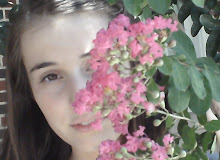
While at TAG (the summer camp I am attending) this year, I have had many dreams. Actually it is odd for me to even dream, because I normally don't. The one that I had last night was one I had had before (but a little different), but is difficult to remember. The last time I had that dream was a really long time ago. But it was about me dancing. I haven't danced since November, due to foot injuries, and because of time, I will probably not be able to dance much again, even when my feet have completely healed. In this dream, one of my friends who is an amazing dancer was insisting I dance her part in a ballet piece for a minute, and she was teaching it to me. I know that there was much much more to the dream than that, and that the whole dream was not focused on ballet. But it's the only part that I remember.
The symbols, patterns, and images in this dream are very clear to me. My friend was in her costume, tutu, tights, and pointe shoes, and I was in jeans, a t-shirt, and sneakers. My hair was in my face instead of being pulled back correctly like my friend's. This would symbolize my being absent from dance, the obvious fact that it has been months and months since I have dressed the part of a ballet dancer. And my embarrassment at not having dressed correctly symbolizes how much I miss dancing, but I know I can't explain why I miss it. It's more of a feeling that I know I can't share but that you would have to experience, because my favorite thing in the the world now is dancing on stage. I have strangely never been nervous, which is exhilarating.
The pattern in that dream was that I kept comparing myself to my friend. She is a much better dance than I am, and I noticed myself comparing my awkward foot movements to hers which I know that I would do the same in dance class, wishing I was as good as the older girls.I also kept wishing that I could have been in class the last few months so that I was not so out of practice.
So now I have a conclusion. There is the obvious assessment that I miss dance, but then there is the second one that just occurred to me as I am typing. That I should try to stop comparing myself to the achievements of others when I know there is no way I would be as good as them or catch up to them. Let's go back to dance. Many of the girls I used to wish I was as good as had been dancing for years longer than I had. So it was an unfair comparison. There is no way I can make up for not starting to dance when I was three, or however old. And I know I won't catch up to them while we are the same age. It's impossible. So I should stop comparing.
I had another dream earlier on into TAG. It was about me and my family unpacking me instead, at a music camp, at Interlochen, the art camp.
My dad went there when he was my age for the music program. He played the clarinet, and so he went there for three weeks, I'm not sure actually how many (though he was accepted for more), to intensely practice his clarinet. Every day.
Before I left home, my piano teacher moved me up a level on my ensemble (where we play the same four handed piano piece with as many as thirty people on fifteen pianos at the same time) team. For the past four years, I have been playing on the elementary team, which for a long time, hasn't fit my age group. So I got moved up a level in age, but also in difficulty. This year, instead of beginner pieces I will be playing a much more challenging piece. For these teams, there are also auditions and so I will have to practice a lot every day if I want to make the team. There is only one really big problem.
I'm at camp. And after that, I will still not have access to a piano for the next three weeks, so that's six weeks total without being able to practice. When I had the dream, I knew what it meant. The symbols are the music, camp, piano, and time. I know that when I come back to the piano, I will have to practice like I'm at Interlochen. A lot, everyday.
Sometimes, like I just did with my dance dream, we assume that we know what dreams are trying to tell us, and why. Sometimes you have to probe at them, and discover what lies just beneath the surface that only takes a little wave of thought to bring it up.
Dreams are very important to the creative process. After the Preparation period, the next step in the creative process is the Incubation Stage. In this stage, the artist has all the ideas down on paper and lets them self day dream. Their mind wanders and they just think about their ideas, trying to see if there is anything else they can come up with. This is a very relaxing time where dreams come in.
Your mind keeps working long after you are asleep, and this is a key concept in the Incubation Stage. A dream can sometimes give you an idea or solution to your creative problem. This is called the Aha! Moment. This is your amazing, creative, genius idea that solves your problem. This is also why dreams are so important to the creative process. Dreams can be the important part of the incubation process that leads to how and where your best ideas are born.
Image: http://www.eso-garden.com/images/uploads_bilder/dream_a_z.jpg


